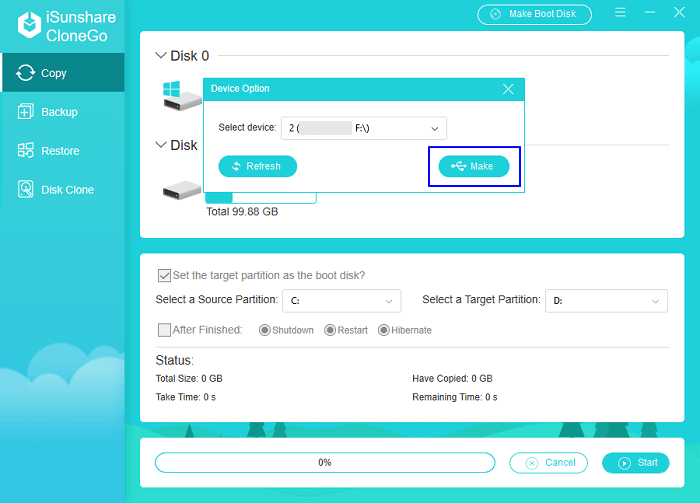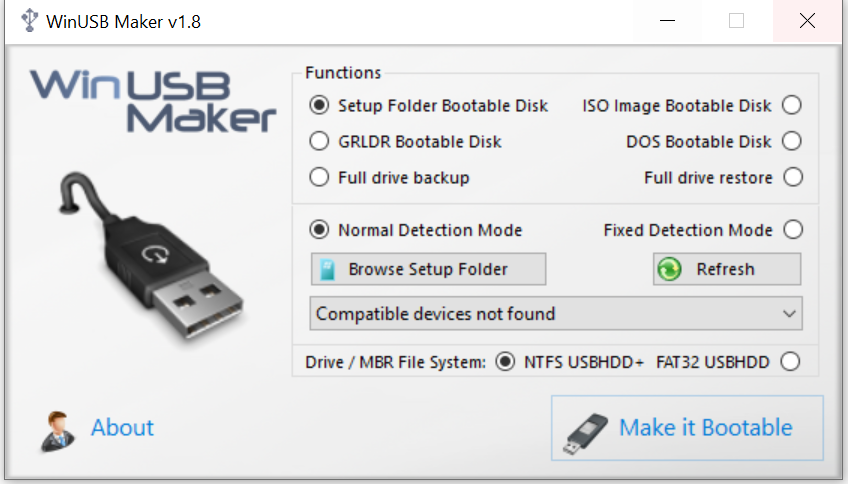
- #Create a usb backup of windows 10 how to
- #Create a usb backup of windows 10 windows 10
- #Create a usb backup of windows 10 windows 8
- #Create a usb backup of windows 10 windows
The official word from Microsoft is that you should use third-party utilities instead.
#Create a usb backup of windows 10 windows
It is at least “deprecated”, and will likely be removed from a future Windows update. Best of all, you already have them in Windows.Īpparently, as of some time in 2020 (or even earlier) Microsoft decided to pull the plug on the “Windows 7 Backup and Restore” tool. Used together, these eight steps and three tools (image backups, File History, and OneDrive) can provide an adequate level of backup for the average user. Recover Deleted Files in OneDrive points out that OneDrive has a Recycle Bin from which you can recover deleted files. As a bonus, Recovering from Ransomware with an Online Backup discusses how it can even save you from ransomware. Just like File History, the day will come when you need to recover a file that’s been backed up to the cloud.
#Create a usb backup of windows 10 how to
Using OneDrive for Nearly Continuous Backup not only shows you how to set up and configure OneDrive itself, but also discusses a couple of simple changes to your workflow that result in almost continuous cloud backup of all your work in progress. Use OneDrive for backing upīacking up to a completely different physical location - “offsite” backup - has never been easier since the advent of cloud storage and synchronization tools like OneDrive. Learn to browse what’s been backed up, locate the file or files you want, and restore them in Restoring Files with File History. Restore a file using File HistoryĪfter you’ve had File History running for a while, you’ll surely encounter a point where you want to recover a file that has been backed up. Using File History, you can recover a file as it was an hour ago, a week ago, or sometime in between, depending on how often files change and how much space you’ve set aside for backups.Įnable File History in Windows tells you how to set it all up.

File History sets aside some amount of space on your hard disk (ideally an external hard disk, and possibly the same one containing your backup images) to which it writes copies of your data files each time they change. With image backups under our belt, we can move on to more “in the background” backups in the form of File History.
#Create a usb backup of windows 10 windows 10
Top-to-bottom, end-to-end, Backing Up In Windows 10 will walk you through all the steps you need to keep your data safe, using Windows 10's built-in tools, as well as a free alternative. The articles listed here have been collected into ebook form - Backing Up In Windows 10- available now. Restore Individual Files from a Windows Image Backup shows you how. Microsoft doesn’t make it obvious, but you can do that from a backup image you create using the Windows backup tool. But sometimes you don’t want to restore everything you just want a single file, folder, or collection.

I rely on image backups primarily because there’s no question about what’s in them: everything. Restoring an Image Backup Using Windows Built-In Backup uses the image we took in step 1 and the recovery drive created in step 2 to demonstrate the process of restoring that image to your computer. An image restore is what you would do after replacing a faulty hard drive with a new, empty one. Restoring an image is the process of taking a backup image you’ve previously created and putting it back on your computer’s hard drive (which erases anything currently on that hard drive).
#Create a usb backup of windows 10 windows 8
You may also want to review the article How Do I Boot from CD/DVD/USB in Windows 8 & 10? (which also applies to 11) and test to make sure you can boot successfully from the recovery drive you’ve created. The Windows recovery disk includes additional tools to examine and possibly repair your system, as well as the ability to reinstall Windows from scratch if needed.Ĭreate a Windows Recovery Drive illustrates the process of creating a recovery drive. This is a disk (a DVD or USB thumb drive) from which you would boot your machine in order to restore the image you created in the first step. Next, I recommend you make a Windows recovery drive. Creating an image of your computer gives you a known point to which you can always return should anything go wrong in the future.Ĭreating a Backup Image Using Windows’ Built-in Backup walks through the steps to create a complete image backup of your machine on an external hard drive using what Windows 10 calls the “Windows 7” backup and restore tool. It doesn’t matter if you don’t know what to do with it - that’ll come later. Start by making an image backup of your computer.

Restore individual files from a backup image.Prepare to restore a backup image in case it’s needed.


 0 kommentar(er)
0 kommentar(er)
